One of my enduring memories of childhood was going in ‘town’, with my parents, on a Saturday morning to do the weekly shop. No Tesco™ in those days, Aberdare had a Fine Fare (anyone else old enough to remember Pink Stamps?) and apart from Boots and Woolworth’s that was about it for national chains.
One of the highlights of our weekly trip was accompanying my father down the arched alleyway in Weatherall Street, into the bake house of Len Godding. Most people went to the bakers shop in Canon St, but we would go to the bake house proper. My father was a coalman and it was he who supplied the coal to fire the oven.
We would get a ‘crusty white’ (my father could not stand his bread to be doughy it had to be crusty) and a Hovis. Len Godding also made miniature Hovis, tiny little loaves just right for one. I would get one of these to myself and consume it later with butter and cheddar cheese. He also made small white rolls from two pieces of dough, the second smaller piece of which was stuck on the top like a crown and egg-washed so it turned golden brown in the over. The joy was in ripping this piece off the top exposing the soft white bread centre underneath.
I can remember the bake house now, always hot of course from that huge oven. Wooden tables covered in metal tins some empty, some full of proving dough. Big metal racks full of cooling loaves. Huge peels (long wooden bakers paddles) leaning against the walls ready to load and unload the ovens. Everything is covered in the white dust of flour. In the corners, where it had been allowed to settle, it mimicked miniature snow drifts blown against the walls.
But what I remember most is the smell, that incredible smell, of fresh baked bread, so complex in its make up, yet so simple in its pleasure. Supposedly the most universally loved smell on the planet and a supposition that I’m not about to disagree with.
Forty odd years later and it is that smell that once again fills my nostrils as I sit in Elisabeth Mahoney’s kitchen in Cardiff, the kitchen that is better known as The One Mile Bakery.
Previous visitors to this blog might have already read my article about The One Mile Bakery’s weekly bread, soup and jam deliveries. If not and you are so inclined you can find it here.
For those that haven’t then The One Mile Bakery is a micro-bakery that delivers fantastic quality freshly baked artisan bread within a one mile radius of its kitchen. Owner Elisabeth Mahoney is also about to start delivering Baking and Cookery Classes and it is to this end that myself and three other Cardiff food bloggers have been invited along to experience the ‘Introduction to Baking Bread’ at first hand.
Sitting with me around the table, that is going to be our work surface for the day, are Nicki Tudor a.k.a Cardiff Bites and Cardiff’s longest established food blogger; Nikki Vivian from the Your Last Mouthful website and fellow food blogger Bev Downes, better known as Eats For Wales.
Four keen bloggers ready to bake.
As we sip our coffees and teas Elisabeth explains to us the format of the day. The aim of this class is to introduce the key stages of baking a loaf (mixing ingredients, kneading, resting, shaping, proving, baking) and to build confidence in each of these in small, easy steps.
To start we will each make a simple loaf, choosing our own flour form a choice of plain white, wholemeal, spelt or malthouse. Nicky and Bev choose to make a basic white loaf, Nikki opts for a spelt and I go for a simple wholemeal.
No matter what flour you are using the recipe is basically the same, although using the different flours side by side certainly allows you to see the different characteristics each type of flower has as you begin to make the dough.
We start by measuring out our flour, putting it in a bowl and making a well, into which we put the yeast and a small amount of tepid water. Then we leave it for 15 minutes until it forms a sludge on top. This means that the yeast has activated. Once this has happened we add the rest of the water and salt and mix it all together.
Make a Well and Add Water to the Yeast
The bubbling shows the yeast is activating.
Then we turn it out onto an un-floured surface (that’s right no flour) and start kneading. It’s about this time that my previous attempts at baking have mostly failed as faced with a sticky, gooey mess I’ve either given up or resorted to sprinkling copious amounts of flour in an effort to regain control that’s lead ultimately to disaster. Elisabeth is adamant that all we have to do is keep kneading for 10 whole minutes. Ten minutes doesn’t seem like a lot of time until you have to knead non-stop for it, but sure enough the longer we go on the less and less sticky the dough becomes as the gluten forms and the dough becomes more elastic. The dough is ready when it springs back to the touch.
You can see the consistency change during kneading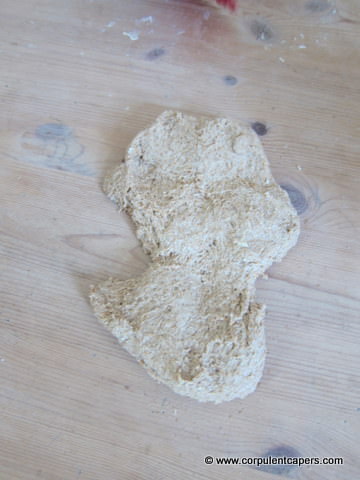
The same dough after 10 minutes kneading
In the following short clip Cardiffbites demonstrates how to knead the worlds stickiest dough – enjoy!
httpv://youtu.be/IlvRrCi0Rh0
An hour later the dough has ‘rested’ and doubled in size, and Elisabeth shows us how to ‘punch down’ and start shaping. This is a bit like origami for dough as we form it into a rough oval and then fold the corners (I know an oval doesn’t really have corners but it’s fairly obvious when you see it done) into the middle.
An hour later and twice the size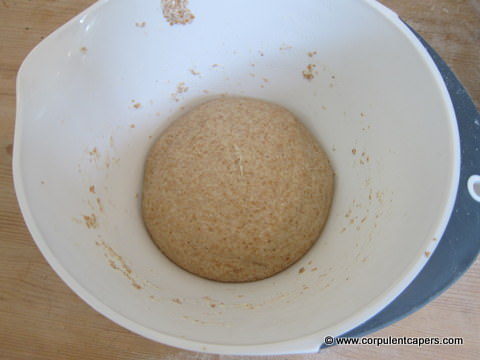
Folding in the Corners - Dough Origami
Then you roll it into a tube, gathering it as you do so, about the length of your tin. Any joints are sealed with the heel of your hand or by gently rolling to smooth them out.
Rolling and Gathering the Dough
Pop it into the tin and leave for about 45 minutes or until it has doubled in size. Then put it into a very hot oven for 35 minutes until it is golden and gives a hollow sound when you tap the bottom. Cool on a wire rack and try to resist eating immediately!
This video shows the loaf coming out of the oven:
httpv://youtu.be/IZLT2r9povE
Throughout the rest of the day I made a rye loaf with caraway seeds that was simply delicious and remained fresh for nearly a whole week, which means we had finished eating it long before it would have gone stale.
Here's a video of the Rye Bread fresh from the oven:
httpv://youtu.be/lDyd8H6hXOY
We also did a mixed flour loaf using white and rye flour that we filled with bacon and red onion.
The culmination of the day was a Pain de Campagne, a French rustic loaf that is made with a pre-dough (also called a ferment) that is prepared in two minutes the day before and added to the dough mix the following day. This was made using a cane banneton to give the characteristic shape.
In between all the mixing, kneading, shaping and baking we discussed why if our bread has 4 ingredients a mass produced loaf from the supermarket needs 24. We learned about different types of yeast, how to slash the bread with a lame and why you should soak any seeds you want to add overnight. Oh and we drank coffee and ate bacon sandwiches as well, although on a real course a proper lunch will be provided while the dough proves.
By the end of the day we all had four loaves of freshly baked bread to take home with us as well as lots of new found knowledge and a big dollop of inspiration for what we could do next.
Elisabeth is a great teacher, with bags of enthusiasm that really rubs off. She is also very passionate about what she does and how she does it, using great ingredients to create great produce. It truly was one of the best days I’ve had in a very long time, because not only was it was great fun but it was also inspirational in equal measure.
In fact I enjoyed it so much I’ll probably be booking myself on the “Introduction To Sourdough Baking’ course later this year. I might even get a gift a gift voucher for MrsA to do “Bread and Jam” as well.
If you’ve got any interest in making breads, jams, or soups then you should do one of these courses. I promise you won’t regret it. Pass the butter……..
Details of all of The One Mile Bakery’s courses can be found here.
The One Mile Bakery
21 Syr David’s Avenue
Cardiff
CF5 1GH
Tel: 07939 211809
Email: info@onemilebakery.com
Web: www.onemilebakery.com
Twitter: @OneMileBakery
Disclosure: I attended this course at the invitation of The One Mile Bakery and as such it was provided gratis.

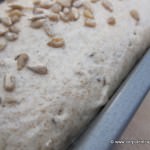
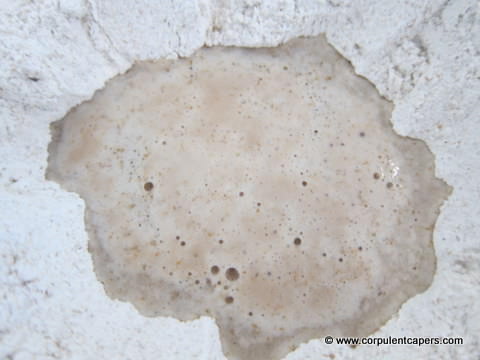

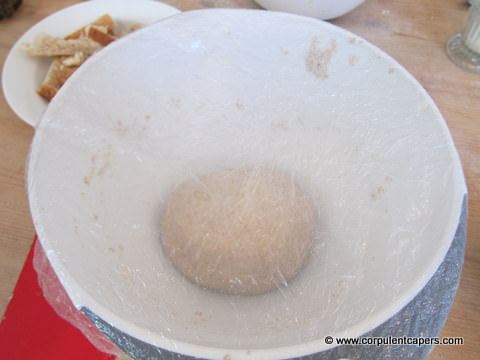
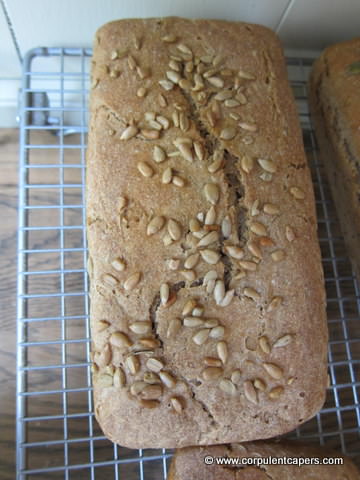
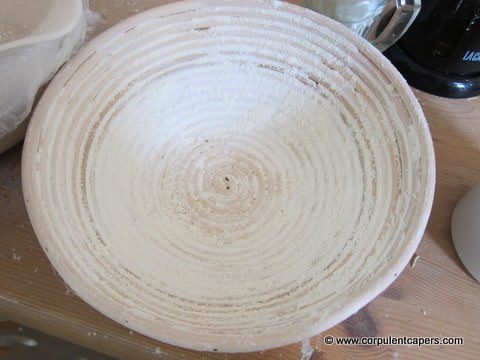






Looks like a fun morning! The world’s stickiest dough has to be Ciabatta, see my fun teaching it in the latest blog post!
What a post! So useful info here! Thanks for sharing.
Wow – this sounds like a fun day. So glad I found your blog through Linkedin. I will be reading through the rest of your articles soon.
Mina
Making bread is so therapeutic, isn’t it. Sounds like a great course.